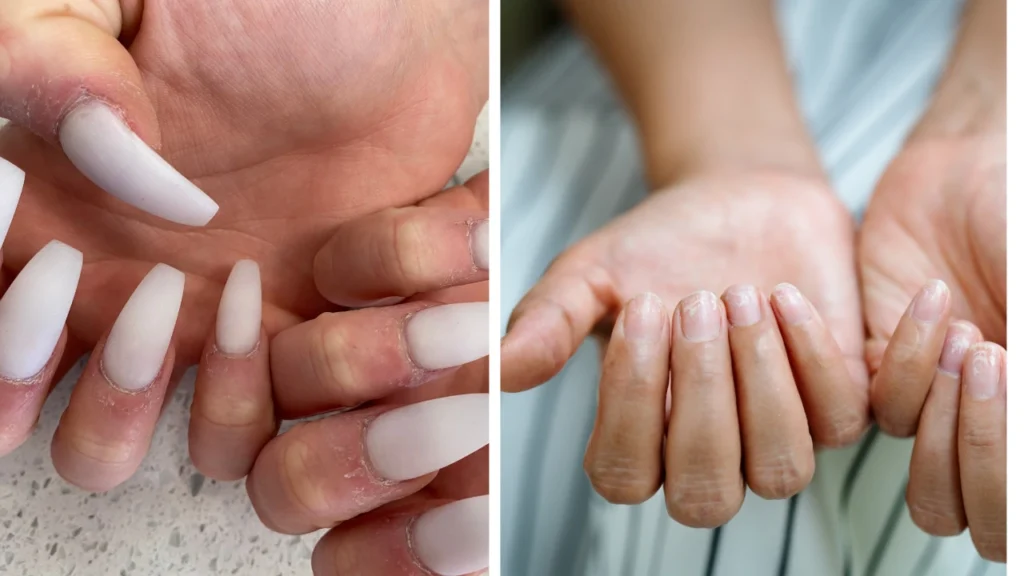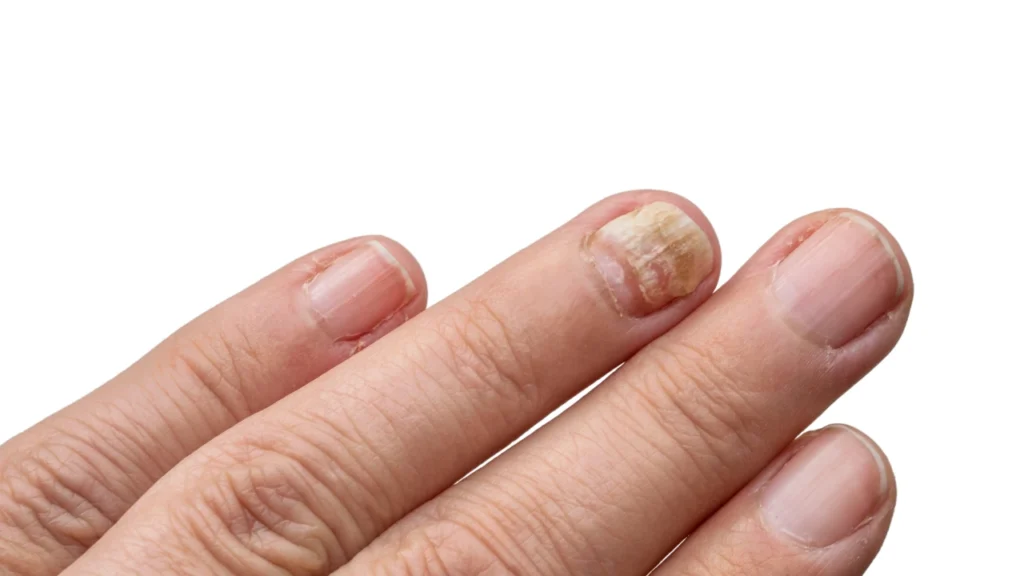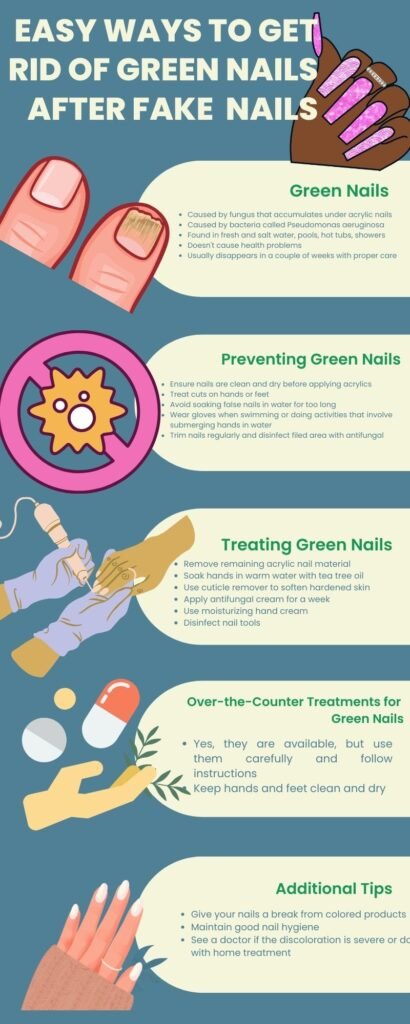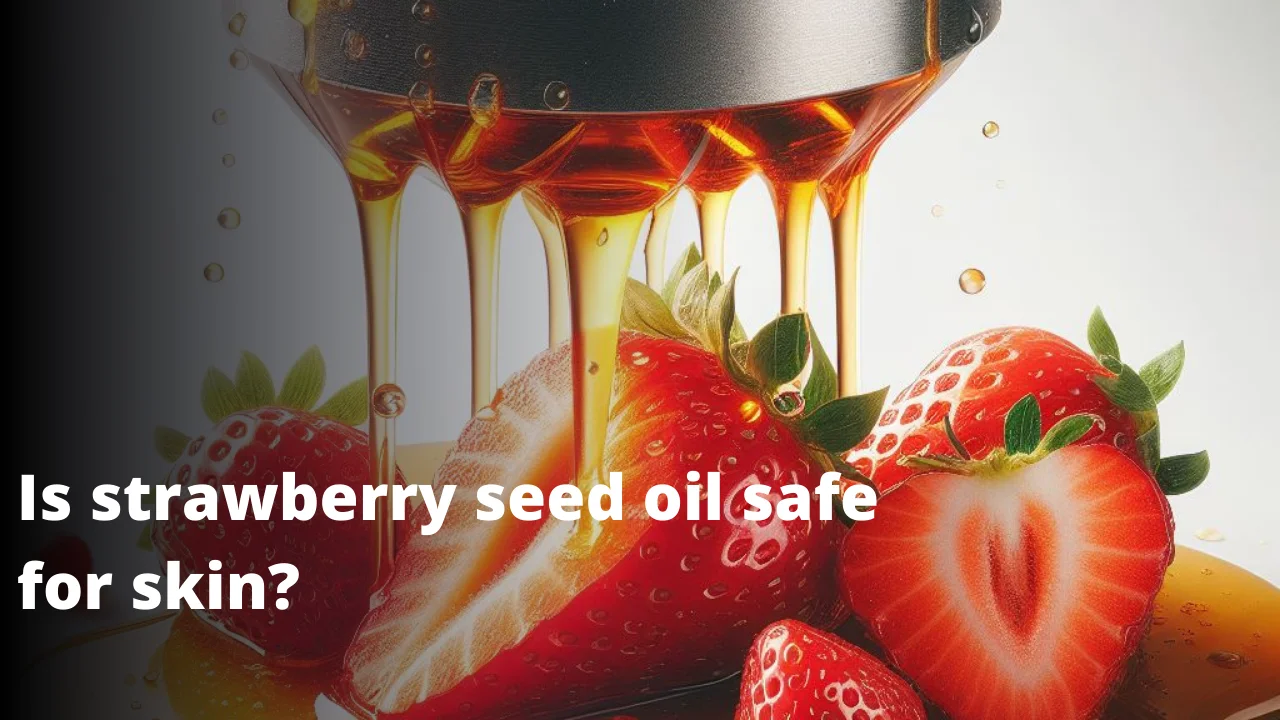Oh no! You’ve just removed your fabulous acrylic nails. Now there are green stains on your natural nails.
You don’t need to panic or get terrified. Having your nails turn green is a disappointment, but it’s a widespread problem that happens to plenty of glam gals.
This green nail problem has a name and is called Green Nail Syndrome. A little bacterial pest causes it. But don’t worry, I’ve got your back!
This article will explore basically why this frustrating green stuff showed up. Furthermore, we’ll also discuss how to get rid of it, and how to prevent it from returning.
I know you want to get back to rocking your flawless nails ASAP, so let’s get started.
First things first – what on earth is Green Nail Syndrome anyway? Read on for intel on all things green nails – from reasons to cures and certainly everything in between.
Plus, I’ll share my pro tips for keeping your fake nails wonderful and green-free for good!
What is Green Nails Syndrome?
Green Nail Syndrome is a bacterial infection of the natural nails. It is caused by Pseudomonas aeruginosa. This bacteria flourishes in a warm and moist environment. It thrives under lifting acrylics also gels, or other fake nails.
The greenish pigment that stains the nail bed can be seen once the bacteria multiplies. As a result green, black, blue, or yellow discoloration is visible on the nail plate and cuticle area.
The discolouration can make your hands look unattractive. However, it doesn’t cause any health problems in most people. It’s more of a visual annoyance than a medical concern.
Green nails mostly appear on one or two nails at a time, especially if you wear fake nails regularly. The pesky Pseudomonas bacteria lingers on nails, tools, and other surfaces. It fervently infects any nails with splits or lifting artificial products.
Regular Signs and Symptoms of Green Nails
These are some of the most common signs and symptoms of Green Nails after wearing fake nails:
- Green, blue, black, or yellow discolouration of one or more nails
- The brittle or weak texture of the infected nail(s)
- Separated or lifted sections of the nail
- White/yellow nail discharge in brutal cases
- The mild smell in advanced cases
- Thickened or hyperkeratotic nail plate
- Puffy or irritated cuticles and nail folds
In some of the rare cases, the skin around the nails may become swollen and tender. However, true green nail infections after wearing fake nails are usually not painful.
Is Green Nails Syndrome Contagious?
Green nails may look alarming but are not contagious. The Pseudomonas infection cannot extend from person to person.
The bacteria however can be transmitted from nail to nail on the same person if proper safety measures are not taken. Using unhygienic tools on multiple nails can intensify the problem. Sealing the bacteria under new artificial nails can also intensify the problem.
Proper decontamination and separation of infected nails prevent the spread. Once the bacteria dry out, they die off and cannot infect other nails.
What Causes Green Nails After Fake Nails?

Now that you know what Green Nail Syndrome is and what causes it? Here are the most common causes
Gaps between natural and artificial nails – Small gaps allow wetness and bacteria to sneak under acrylics or gel polish. Keeping lifted nails helps in bacterial growth.
Improper application – Fake nail’s inappropriate application can lead to detachment and moisture buildup. This happens when fake nails cover the skin instead of carefully hugging the natural nail line.
Incomplete natural nail prep – You have to get your nails thoroughly cleaned before artificial nail application. Otherwise, this leaves the door wide open for Pseudomonas.
Reusing Infected Tools – You need to make sure that the tools used are properly disinfected. Bacteria easily clings to nail files, clippers, and brushes so you have to be certain that they are clean.
Excess moisture – The pesky Pseudomonas bacteria traps in damp environments like showers, pools, sinks, and hot tubs. Keeping hands constantly wet raises the infection threat.
Frequent artificial nail use – Acrylics and gels tend to cause more Green Nail Syndrome than other artificial alternatives. Regular use without rest periods denies nails of oxygen.
Nail picking and improper removal – Peeling off mock nails can rip off layers of the natural nail, creating gaps and access points for bacteria.
Basic health conditions – Diabetes, nail damage, compromised immune system or poor circulation increase vulnerability to nail infections.
Who is Most at Risk?
You may be more prone to developing green nails if:
- You wear acrylics, gels, dip powder, or other fake nails regularly
- You reuse nail tools and supplies without appropriate disinfection
- You have a habit of picking at or improperly removing fake nails
- You don’t take regular breaks from artificial nails (every 2-3 months)
- You have a medical condition like diabetes or circulation issues
- You take oral steroids, immunotherapy or chemotherapy
- Your immune system is weakened for any reason
- You’re over age 65 and have thinner, fragile nail plates
How To Get Rid of Green Nails
Ready to get rid of those horrible green stains from your nails? Here are the steps to treating Green Nail Syndrome
Remove artificial nails – Carefully take off gels, acrylics, or dip powder following pro suggestions. Sanitize and trim your natural nails after soaking or filing off all remaining products.
Kill the infection – Infuse your nails in vinegar, rubbing alcohol, or diluted bleach to wipe out bacteria and dry out the nails. Tea tree oil, hydrogen peroxide and iodine also work.
Let nails grow – The green stains won’t disappear right away but rest guaranteed the bacteria are dead. Be patient – it takes 1-4 months for uninfected new nail growth.
Avoid recontamination – Don’t put artificial nails over green ones. Also, keep nails dry and wear gloves for dishwashing, cleaning, and other wet tasks.
Use topical antiseptics – Apply over-the-counter antibiotic creams having neomycin or mupirocin 2-3 times daily while waiting for nails to grow out.
Take nail supplements – Biotin, vitamin E, and zinc can help fortify nails and stimulate regrowth.
File away stains – As your nails grow out, use a nail file to lightly polish away the remaining greenish tint on the rising nail plate.
Cover stains temporarily – Paint on nail polish or use nail stickers to conceal stained nails while waiting for them to clear.
See a doctor – If home care doesn’t resolve the contagion or you have returning issues, see your doctor for instruction treatments.
Home Remedies for Green Nails
If you want to try natural DIY treatments before seeing a doctor, here are some home remedies that can help clear up Green Nail Syndrome:
White vinegar soak – The acetic acid in vinegar kills bacteria and dries out the nail bed. Soak nails in it for 10-15 minutes daily.
Hydrogen peroxide – The bubbling of hydrogen peroxide disinfects nails. Dip cotton balls in 3% solution and apply to nails 2-3x daily.
Tea tree oil – The antimicrobial properties make tea tree oil a great natural disinfectant. Dab oil on nails 2-3x daily.
Oregano oil – This anti-fungal vital oil may combat immovable nail fungus when used 2x daily.
Listerine mouthwash – The antiseptic ingredients in the blue Listerine formula can kill germs when used as a nail soak.
Bleach soak – A watery bleach solution of 1 part bleach to 4 parts water destroys bacteria when used as a 5-minute nail soak.
Apple cider vinegar – It contains acetic acid which is another effective nail infection home remedy.
Vicks VapoRub – The camphor and menthol inhale germs, making Vicks a household staple for green nails.
Always appropriately dilute oils and treatments and limit soaks to 5-10 minutes to avoid over-drying nails. While home care can help, severe or recurring cases need specialized treatment.
When To See A Doctor
In most cases, you can treat Green Nail Syndrome after wearing fake nails at home without medical involvement. However, it’s best to check with your doctor in certain situations:
The infection worsens or spreads to multiple nails
- You have diabetes, immune deficiencies, or other underlying health conditions
- Your nails remain green, detached, or thickened after home treatment
- You experience redness, swelling, oozing pus, or increased pain
- You have recurring issues with green nails
Seeking medical advice provides you with more treatment options like:
Prescription antibiotic ointments – Topical antibiotics like mupirocin are more effective at killing nail bacteria than over-the-counter products.
Oral antibiotics – For severe or recurring pseudomonas infections, doctors may recommend oral antibiotics like ciprofloxacin.
Antifungal medications – In some cases, an anti-fungal drug is needed in addition to antibiotics.
Medicated nail polish – Prescription polishes like ciclopirox can aid in clearing up stubborn nail fungus.
Acetic acid treatments – For a brutal infection, a doctor may suggest concentrated acetic acid applied directly to the nail 1-2 times per week.
Debridement – In serious cases, scratching off infected parts of the nail in a medical setting speeds curing.
Don’t try to tough it or cover up green nails with polish or new acrylics. Always address the underlying problem. Seeking professional medical advice helps in the long run. It provides the best chance of getting your nails back to a healthy state.
Avoiding Green Nails

A small amount of prevention is worth a pound of cure when it comes to Green Nail Syndrome. Here are pro tips for avoiding green nails in the future:
Take habitual nail breaks
Give your nails a rest between acrylic or gel manicures every 2-3 months. The break permits your nails to rehydrate and recover from chemical exposure. Trim and polish your natural nails during these rest periods.
Handle lifting promptly
At the first sign of lifting nails, remove the fake nails entirely or fix the lifted edges the same day. Don’t let wetness and bacteria crawl under partially separate nails.
Prep nails thoroughly
Filing, trimming, polishing, and dehydrating your natural nails beforehand removes debris and oils. Bacteria usually cling to these substances. Use a dehydrator or alcohol wipe even if your nails appear clean.
Avoid overfilling natural nails
Unnecessary filing thins your nail plates, making them prone to cracking and lifting. Use a tender touch and proper nail tools.
Apply artificial nails properly
Make certain that nails fit carefully without overlaying your skin or cuticles. Follow all steps to maximize grip and prevent detachment. Avoid applying on damaged nails.
Disinfect attentively
Always sterilize nail tools and surfaces between clients with EPA-registered disinfectants. Assign each client dedicated tools whenever possible.
Keep hands dry
Carefully dry hands after washing. Wear gloves for dishwashing, cleaning, gardening, and other wet tasks. Avoid soaking hands for too long. Trim nails after showering.
Wear gloves when using harsh chemicals
Wear water-resistant gloves when using cleaning products, solvents, detergents, and other chemicals that can damage nail beds.
Use new nail files and buffers
Throw away used emery boards, pumice stones, and buffing blocks after each use. Never share these tools even if you disinfect them.
Get timely appointments
Schedule appointments every 2-3 weeks. Replace lifted sections and fill new nail growth before sizable gaps appear.
Educate on proper at-home removal
Soak off gels only. Avoid picking, peeling, or stressing nails during removal. File gently. Disinfect nails afterwards.
Stick to reputable nail salons and technicians who follow hygiene best practices. Educate yourself on the application do’s and don’ts. Stay cautious with daily nail care.

Outlook for Green Nails
When treated promptly and properly, the prognosis for Green Nail Syndrome is excellent. Here’s what you can expect:
- With home treatment, most mild cases fully clear in 1-2 months as the nails grow out.
- Oral or topical antibiotics prescribed by a doctor speed healing. It shortens the recovery period to 2-4 weeks.
- The greenish staining often hangs on at the base of nails as they grow but is only aesthetic.
- Once the underlying infection is eliminated, nails return to their normal appearance with regrowth.
- Recurrences are common if artificial nails are reapplied too soon. It also happens when underlying causes like diabetes or nail biting aren’t addressed.
- Practising good nail hygiene reduces the risk of infection. Taking preventive steps also reduces the risk.
- Severe or continual cases may need prescription medication. They may also require temporary abstinence from fake nails until the nails are repaired.
- With timely treatment and preventive care, most people can resume artificial nails after a Green Nail Syndrome episode without issue.
So don’t panic the next time you remove your gels and notice green staining. Arm yourself with the knowledge of how to get rid of Green Nail Syndrome for good. Here’s to many more months of flawless nails ahead!
Conclusion
The prospect of green nails is not pleasant. Rest assured that Green Nail Syndrome is a common cosmetic nuisance. It can only be remedied with watchfulness and proper care.
Here are the key takeaways to remember:
- Green nails are caused by a bacterial infection, not nail fungus. Pseudomonas aeruginosa is the cause.
- The bacteria flourish under lifted artificial nails in wet conditions. Inappropriate application and nail damage also raise the risk.
- Treatment involves removing fake nails. Then you need to disinfect with solutions like alcohol or vinegar. Allow the stains to grow out over 1-4 months.
- Prevent reoccurrence by taking nail breaks. Handle lifting promptly, prep nails thoroughly, and keep hands dry.
- See a doctor if the infection continues or worsens despite home treatment. Treatment of topical and oral antibiotics can help clear even brutal cases.
- With proper nail sanitation and punctual treatment, you can get back to wearing remarkable artificial nails without the fear of infection.
So don’t panic the next time you take out your gels and notice green staining. Arm yourself with the awareness of how to drive out Green Nails after wearing fake nails for good. Here’s to many more months of flawless nails ahead!



